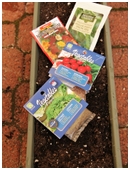Plant a Fail-Safe Veggie Garden
What happens when you give kids dirt, a shovel, and a squirting hose? Chances are, a little chaos, and a lot of fun. Now, with summer here, you can add even more delight—and some lasting science lessons too—by throwing seeds into the mix. With just a few inexpensive supplies, you and your child can plant a first vegetable garden together.
Gardening, of course, offers endless possibilities. For children, though, it’s best to start small, with quick, hardy plants. And you don’t need a huge backyard to do it. This easy, “brown thumb-proof” garden fits in a patio planter. Get ready for happy mess!
What You Need:
- Rectangular planter, at least 2-3’ long, 8” high, and 10-12” wide.
- 1 seed packet each: radishes, lettuce, nasturtium, and sugar snap peas (look for the dwarf/bush variety, which stand alone).
- 1 large bag of potting soil (enough to fill your planter)
- Trowels
- Watering can
- Flat sticks for labels
What You Do:
- Check the weather and pick your spot. These are cool-weather seeds, but beware of frost: start planting when night temperatures are regularly above freezing! Also, find a spot with direct sun at least several hours daily. If you’ve got a budding scientist, it’s also a great time to point out how plants need light to grow.
- Prepare your soil. Gardens always start with good dirt. Empty your potting soil into your planter and smooth the top, but don’t push it down—airy soil will help nourish your seeds.
- Plant peas. Plant peas in a row, roughly 2” apart, at least an inch away from one long edge of your planter. To plant, have your child place the seed on top of the soil, and then poke it down about an inch, and smooth the soil over it. Write “peas” on a label and place it at the end of your row.
- Plant your other seeds. The other seeds grow well in patches rather than rows. Leave about two to three inches from your pea row, and then mark off three rectangular patches: one each for lettuce, nasturtiums, and radishes. Large-seeded nasturtiums can be planted the same way as peas, at least 3” apart. Lettuce and radish seeds are smaller; sprinkle them out and cover with a light blanket of soil. Once you have planted your seeds, be sure to mark them. Give them a good, gentle drenching as well. This is a great time to talk about how our plants start from seeds of all shapes and sizes. Which seeds are biggest? Roundest? Weirdest?
- Tend your garden. The next several weeks are full of delights. Water daily, and you will soon see sprouts. Some of your lettuce and radish plants may be too close together—you can thin them to about 2-3” apart. Help your child identify plant parts: roots, stems, leaves, and flowers.
The best thing about this garden is it’s almost instant gratification—within days you’ll see the first sprouts. Within six weeks, you should harvest your first lettuce and radishes, and within nine weeks you should be able to pick peas and make a bright nasturtium bouquet for the table. Adventurous eaters may even put nasturtium leaves and flowers in a salad! With luck, your harvest will last even longer: your child will begin a lifelong love for a green and growing world.

Kate is the founder of Learn and Grow Books, which is a website for parents and teachers of pre-K children.

